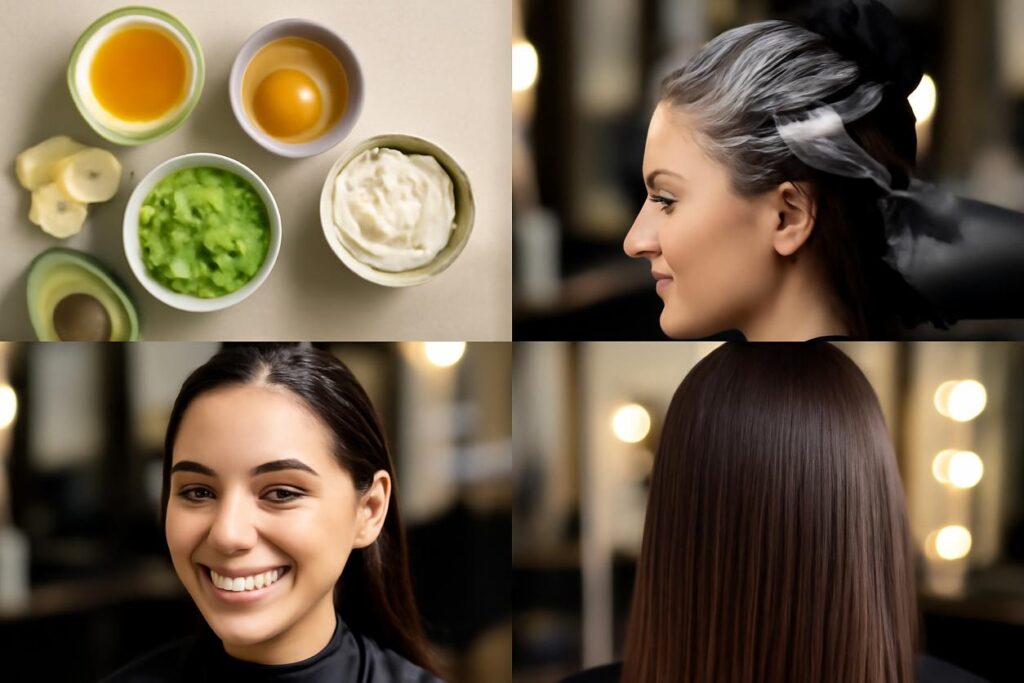Table of Contents
- Quick overview — What causes frizz?
- How hair structure and porosity influence frizz
- Daily morning routine for taming frizz
- Key ingredients that reduce frizz and why they work
- Weekly treatments and evening rituals
- Adapting your routine by season and humidity
- Tools, heat tips and safe temperature ranges
- Product layering: order, purpose and timing
- Fast fixes for unexpected frizz
- Common questions about frizz and realistic expectations
- 7-step summary routine checklist (printable)
Quick overview — What causes frizz?
Frizz is the frustrating halo of flyaways that appears when your hair’s outer layer, the cuticle, is raised instead of lying flat. Think of your hair strands like a roof covered in shingles. When the shingles (your cuticles) are smooth and flat, your hair looks sleek and shiny. But when they lift, your hair can look puffy and undefined.
This lifting happens for two main reasons: a lack of moisture within the hair strand and an abundance of moisture in the air (humidity). When your hair is dry, it desperately seeks moisture from the surrounding environment. As humid air penetrates the raised cuticles, the hair shaft swells unevenly, resulting in that dreaded frizzy texture. Therefore, effective frizz control is all about balancing your hair’s internal moisture levels and smoothing that outer cuticle layer.
How hair structure and porosity influence frizz
Understanding your unique hair is the first step toward lasting frizz control. Every strand is made of three layers, but it’s the outermost cuticle and its condition that primarily determine frizz. This condition is closely tied to your hair’s porosity, which is simply its ability to absorb and retain moisture. For more in-depth information on the science of hair, resources like Rich Hair UK can offer valuable insights.
- Low Porosity: Cuticles are tightly packed and lie flat. This hair type resists moisture, making it hard to get wet, but once hydrated, it holds onto moisture well. It’s prone to product build-up but less prone to humidity-induced frizz.
- Medium Porosity: The cuticle layer is looser, allowing moisture to penetrate and be retained effectively. This is often considered the “ideal” porosity, requiring the least amount of maintenance for frizz control.
- High Porosity: The cuticles have gaps or holes and are often raised. This hair absorbs moisture very quickly but loses it just as fast. It’s highly susceptible to frizz because it constantly tries to absorb moisture from the humid air. Damage from heat or chemical treatments can increase porosity.
How to test porosity at home
You can perform a simple test to identify your hair’s porosity. Make sure your hair is clean and free of any product.
- Pluck a single, clean strand of hair.
- Drop the strand into a glass of room temperature water.
- Observe its behaviour for 2-4 minutes.
- If it floats at the top, you likely have low porosity hair.
- If it sinks slowly or floats in the middle, you likely have medium porosity hair.
- If it sinks quickly to the bottom, you likely have high porosity hair.
Daily morning routine for taming frizz
Your morning routine sets the stage for a frizz-free day. The key is to be gentle and strategic with moisture. After washing, avoid rubbing your hair with a rough cotton towel. This friction raises the cuticle instantly. Instead, gently squeeze out excess water using a microfibre towel or a soft cotton t-shirt. Apply your styling products while your hair is still damp, not soaking wet or fully dry, to lock in hydration effectively.
Styling techniques by hair texture (straight, wavy, curly, coily)
How you apply products matters just as much as what you apply. Tailor your technique to your texture for optimal frizz control.
- Straight Hair: Apply a lightweight smoothing cream or serum from the mid-lengths to ends. Brush through with a boar bristle brush to distribute the product evenly and smooth the cuticle down.
- Wavy Hair: Use the “praying hands” method to glaze a lightweight mousse or gel over your waves. Then, gently scrunch upwards to encourage your wave pattern without creating friction. Try “plopping” your hair in a t-shirt for 10-20 minutes to enhance definition and reduce frizz while it dries.
- Curly Hair: Apply a leave-in conditioner followed by a curl cream using the “raking” method (using your fingers like a rake). For extra definition and hold, apply a gel using the “praying hands” method to clump curls together.
- Coily Hair: This texture often benefits from the LOC (Liquid, Oil, Cream) or LCO (Liquid, Cream, Oil) method. After applying a water-based leave-in (Liquid), seal it with a cream and then an oil (or vice-versa) to lock in maximum moisture. The “shingling” technique, where you apply product to small individual sections, can provide superior definition and frizz control.
Key ingredients that reduce frizz and why they work
Reading ingredient labels is a superpower in the fight for frizz control. As we look at hair care trends for 2025 and beyond, the focus is on smart formulations that work with your hair’s biology. Look for these powerful ingredients:
| Ingredient Type | Examples | How It Works |
|---|---|---|
| Emollients & Oils | Shea butter, argan oil, jojoba oil, mineral oil | They coat the hair strand, sealing the cuticle and preventing moisture from escaping or entering. This creates a barrier against humidity. |
| Humectants | Glycerin, hyaluronic acid, panthenol | These attract moisture from the air into the hair. They are best used in moderate humidity or layered under a sealant. |
| Silicones | Dimethicone, amodimethicone | They form a lightweight, water-resistant coating on the hair, smoothing the cuticle and blocking humidity very effectively. |
| Hydrolyzed Proteins | Keratin, silk, wheat, or soy protein | These small protein fragments temporarily patch the gaps in a damaged, porous cuticle, making the hair stronger and smoother. |
| Polymers | PVP, Polyquaternium-69 | These are film-formers found in gels and mousses. They create a “cast” around the hair that provides hold and acts as a powerful shield against frizz. |
Ingredients and ingredients combinations to avoid
Just as some ingredients help, others can hinder your frizz control efforts.
- Short-chain Alcohols: Be wary of products high on the ingredient list with SD alcohol, denatured alcohol, or isopropyl alcohol. These can be very drying and will lift the hair cuticle.
- Harsh Sulfates: Cleansers with Sodium Lauryl Sulfate (SLS) can strip your hair of its natural oils, leaving it dry, vulnerable, and prone to frizz. Opt for sulfate-free shampoos.
- Glycerin in High Humidity: For some hair types, especially high porosity hair, a product with high levels of glycerin can backfire in very humid weather. As a powerful humectant, it can pull too much moisture from the air, causing the hair shaft to swell and frizz.
Weekly treatments and evening rituals
Consistent care is crucial. Incorporate a deep conditioning treatment or a hair mask into your routine once a week. This replenishes moisture deep within the hair shaft, making it more resilient to frizz. Your nighttime routine is equally important. Friction against a cotton pillowcase can rough up your cuticles overnight. Protect your hair by sleeping on a silk or satin pillowcase or by wearing your hair in a loose bun or braid secured in a satin scrunchie or bonnet.
Gentle DIY mask suggestions (with safe measurements)
For a simple, at-home treatment, you can try one of these masks.
- Hydrating Avocado Mask: Mash half a ripe avocado and mix with 1 tablespoon of olive oil. Apply to damp hair, leave on for 20 minutes, then rinse thoroughly before shampooing.
- Smoothing Yogurt Mask: Mix 3 tablespoons of plain, full-fat yogurt with 1 tablespoon of honey. Apply to hair, focusing on mid-lengths and ends. Leave for 15-20 minutes and rinse well.
Adapting your routine by season and humidity
Effective frizz control isn’t a one-size-fits-all-year-round strategy. You must adapt to the weather.
- High Humidity (e.g., Summer): The air is full of moisture your hair wants to absorb. Your goal is to block it out. Use products with strong anti-humectant properties like silicones or film-forming polymers (gels). Sealing oils are your best friend.
- Low Humidity (e.g., Winter): The dry air will try to suck moisture out of your hair. Your goal is to add and seal in moisture. This is when moisture-attracting humectants like glycerin and hyaluronic acid are most beneficial, layered underneath rich creams and butters to lock the hydration in.
Tools, heat tips and safe temperature ranges
When using heat, always use a heat protectant spray. It creates a barrier between the tool and your hair, preventing moisture loss and cuticle damage. Consider using an ionic hairdryer, which emits negative ions that help break down water molecules faster, reducing drying time and heat exposure while smoothing the cuticle.
Never use heat tools on hair that is not 100% dry. Adhere to safe temperatures to prevent irreversible damage that leads to chronic frizz.
| Hair Type | Recommended Temperature Range |
|---|---|
| Fine or Damaged Hair | Below 150°C (300°F) |
| Medium or Healthy Hair | 150°C – 190°C (300°F – 375°F) |
| Coarse or Thick Hair | 190°C – 220°C (375°F – 425°F) |
Product layering: order, purpose and timing
The order in which you apply your products significantly impacts their effectiveness. The general rule is to go from the lightest product to the heaviest to ensure each layer can penetrate the hair properly.
- Leave-in Conditioner (Water-based): Apply to damp hair first. Its purpose is to hydrate and detangle, providing a baseline of moisture.
- Cream (Moisture/Definition): Apply a curl cream or smoothing cream next. Its purpose is to moisturise and condition, clumping curls or smoothing strands.
- Gel or Mousse (Hold/Seal): This is your primary frizz control shield. It forms a cast to define your style and seal the cuticle against humidity.
- Oil or Serum (Seal/Shine): Use a very small amount as the final step once hair is mostly or fully dry. Its purpose is to seal everything in, add shine, and break any stiff “cast” from your gel.
Fast fixes for unexpected frizz
Even with a perfect routine, frizz can happen. For a quick touch-up, try one of these tricks:
- Lightly mist the frizzy sections with water to reactivate the product already in your hair, then re-scrunch or smooth.
- Warm a tiny drop of hair oil or serum between your palms and lightly glaze it over the surface of your hair.
- Spray a light-hold hairspray onto a clean spoolie or toothbrush and gently comb down flyaways at your part and hairline.
Common questions about frizz and realistic expectations
Can frizz be eliminated completely?
Realistically, no. A small amount of frizz is natural, especially for textured hair. The goal of a good frizz control routine isn’t total elimination but significant management. It’s about working with your hair to make it look its best, not forcing it to be something it’s not.
How long does it take to see results?
You can see immediate improvement after one wash day with the right techniques and products. However, to improve your hair’s underlying health and resilience to frizz, it takes consistency over several weeks. Damaged, high-porosity hair will take longer to see lasting results than healthy, low-porosity hair.
Is frizz always a sign of damage?
Not necessarily. While damaged hair is almost always frizzy, undamaged hair can also experience frizz due to its inherent structure (like curly hair) or environmental factors like humidity. Frizz is simply a signal that your hair’s cuticle is raised and needs moisture balancing.
7-step summary routine checklist (printable)
Use this weekly checklist to stay on track for ultimate frizz control.
- 1. Cleanse Gently: Wash with a sulfate-free shampoo, focusing on the scalp.
- 2. Condition & Detangle: Apply conditioner from mid-lengths to ends. Detangle gently with fingers or a wide-tooth comb while conditioner is in.
- 3. Squeeze, Don’t Rub: Use a microfibre towel or t-shirt to gently squeeze water out of your hair.
- 4. Apply Products to Damp Hair: Layer products from lightest to heaviest (leave-in, cream, gel).
- 5. Style with Finesse: Use texture-appropriate techniques (scrunching, praying hands, raking).
- 6. Dry Smartly: Air-dry or use a diffuser on low speed and low heat.
- 7. Protect Overnight: Sleep on a silk/satin pillowcase or use a bonnet/scarf.






